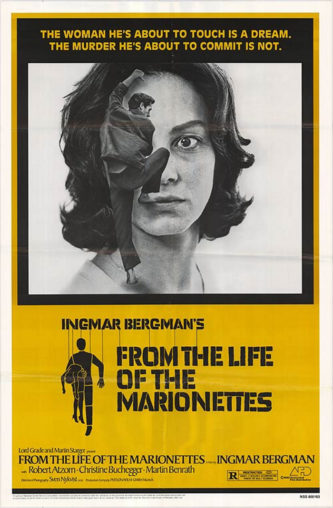 A German language psychothriller from the legendary Ingmar Bergman that pivots on the disturbed psyche of a murderer. In Bergman’s distinguished filmography it’s only medium grade, but by most any other standard this is a standout film.
A German language psychothriller from the legendary Ingmar Bergman that pivots on the disturbed psyche of a murderer. In Bergman’s distinguished filmography it’s only medium grade, but by most any other standard this is a standout film.
FROM THE LIFE OF THE MARIONETTES (AUS DEM LEBEN DER MARIONETTEN) was a telefilm Ingmar Bergman made in 1980, during his years of tax exile in Germany. It was a sequel of sorts to SCENES FROM A MARRIAGE (1973), focusing on a married couple who had a supporting role in that film. FROM THE LIFE OF THE MARIONETTES received generally poor reviews (in the US at least), although Bergman himself judged it one of his “most important” works.
Incidentally, you comic book fans may recall this film being referenced in an early issue of THE SANDMAN, where it was listed among the preferred viewing choices of a convention of serial killers.
A man, one Peter Egermann, impulsively strangles a prostitute, and then has sex with her corpse (off-screen). We hear from Peter’s psychiatrist, the cold and calculating Professor Jensen, who professes shock at his patient’s behavior–yet a flashback shows Peter in Jensen’s office a day before the killing, describing in great detail how he wants to murder his fashion designer wife Katarina. The latter, we learn, is having an affair with Jensen, of which Peter is well aware.
A week after the murder we hear from Peter’s mother, who reports there was “nothing unusual” about Peter in the days leading up to the calamity. A flashback to a night Peter spent five days before the murder, however, suggests otherwise: Peter and Katarina are unable to sleep, and she comments on his unhappy air, the reasons for which he’s unable to articulate.
Tim, a gay business partner of Katarina, is interrogated about his part in the murder. It seems he knew the murdered prostitute and introduced her to Peter, although Tim in fact has his own designs on Peter, with whom he’s admittedly besotted.
Next we get a monologue describing a dream experienced by Peter involving an imaginary woman he caresses with fingers bearing tiny eyeballs at their tips. Later in the dream he attempts to have sex with Katarina and finds her dead, apparently from his hand.
Another flashback shows Peter attempting to jump off the roof of his apartment building a week before the murder. He doesn’t go through with the suicide, instead getting into an argument with Katarina, who has threatened to leave him following a physical attack. She taunts him, which inspires another attack.
A final flashback details Peter’s fateful encounter with the unfortunate prostitute. Said encounter takes place after the strip club in which the prostitute works closes for the night, with all the doors locked. The two get to talking, and Peter is shocked to learn the prostitute’s name is Katarina, just like his wife. He complains, cryptically, that “There’s no way out!“…and events take their inevitable course.
Abnormal psychology was a mainstay of Ingmar Bergman’s filmmaking, so this film, exploring the psychology of a murderer, was long overdue. I’m just surprised it arrived so late in Bergman’s career.
It’s extremely clinical in nature, and dialogue heavy. The theatrical format, which will be familiar to longtime Bergman viewers, is exacerbated by the investigative structure, which consists largely of people describing their relationship with the protagonist to an off-screen investigator. The sexual angle is notably frank, with extensive nudity and much blunt talk about carnal matters that will surely turn off the arthouse patrons who constitute Bergman’s target audience.
Equally contentious is Bergman’s use of dreams to advance the narrative, and the film’s pervasive obsession with murder and bloodletting (evinced by a lengthy monologue about the amount of blood a person emits when his/her neck is slashed). Mirrors, unsurprisingly, play a big part in Bergman’s visual design, indeed perhaps a bit too much: subtle this film isn’t.
I could have also done without the closing monologue by the psychiatrist, which too-neatly sums up Peter’s psychological issues, something the preceding film did just fine on its own. The acting by a largely unknown German cast isn’t up to the level of more distinguished Bergman regulars like Max von Sydow and Liv Ullmann, but isn’t bad, with Martin Benrath as the severely disturbed Peter being the standout.
Most impressive of all is the gorgeous cinematography by the great Sven Nykvist, Bergman’s usual cinematographer, who bathes the majority of the film in black and white that turns to lurid primary color in the opening and closing scenes.
Vital Statistics
FROM THE LIFE OF THE MARIONETTES (AUS DEM LEBEN DER MARIONETTEN)
Personafilm GMBH
Director: Ingmar Bergman
Producers: Ingmar Bergman, Horst Wendlandt
Screenplay: Ingmar Bergman
Cinematography: Sven Nykvist
Editing: Petra v. Oelffen
Cast: Robert Atzorn, Christine Buchegger, Martin Benrath, Rita Russek, Lola Muthel, Walter Schmidinger, Heinz Bennent, Ruth Olafs, Karl-Heinz Pelser, Gaby Dohm, Toni Berger, Erwin Faber
